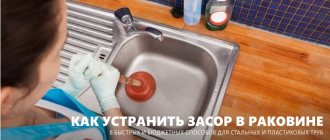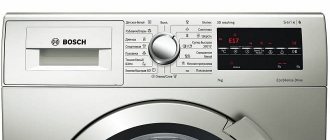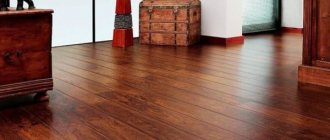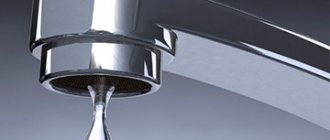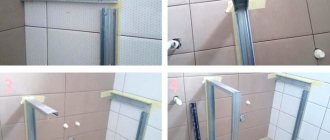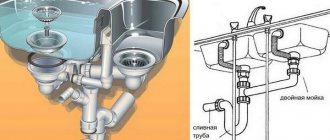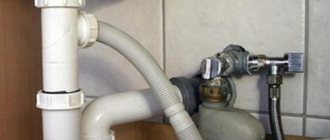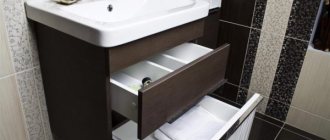Very often, various kinds of problems arise with bathtubs and sinks, or rather with draining water from them. There may be various reasons for stagnation, in which water will accumulate and cannot immediately drain into the pipe. Knowledgeable people may begin to look for the problem inside the pipes or try to remove the blockage, and if the cause was not found, they will certainly call a plumber. However, you should not rush to seek qualified help; perhaps the problem is much simpler, and it is quite easy to solve.
Why doesn't the water go away?
Water does not drain well from the sink only because it is clogged. However, there can be any number of sources of blockage. Most often, the drain becomes clogged with a lump of food debris, fat, hair, detergents, which gradually collect in the siphon, grow on its walls and narrow the lumen.
In addition, all sorts of small objects can get into the pipe: pieces of paper, paper clips, buttons, bottle caps, parts of a children's construction set. They can get stuck not only in the siphon, but also in any other place in the drain, preventing complete drainage. The method for eliminating it depends on the cause of the blockage. Therefore, before starting to solve the problem, it is recommended to determine its source.
What should never be flushed down the sink?
- Flour. Everyone knows perfectly well what happens to flour when it comes into contact with water: it becomes a sticky, swollen lump that clogs the duct. For the same reason, you should not wash off the semolina and starch.
- Coffee. Particles of ground aromatic powder settle on the walls, eventually leading to blockage.
- Rice. Rinse boiled cereals very carefully: grains of rice, getting into the sewer pipe, stick to each other and to other food.
- Dye. Or other construction viscous liquids - the reason is clear.
- Shell. Small sharp particles will not do anything on their own, but with their corners they cling to other food and form a garbage “snowball”.
Many people encounter blockages: now you know that you can even remove them yourself. But in serious situations, do not hesitate to call a plumber. A specialist who arrives on time can save you from replacing pipes, flooding your neighbors and other unpleasant situations.
Folk remedies for cleaning pipes
There are folk remedies that traditionally help maintain kitchen drain hygiene without the use of industrial chemicals.
Recipe No. 1 Soda + vinegar
Before you start cleaning with baking soda and vinegar, you need to remove all accumulated water from the sink. After this, approximately 100 g of baking soda is poured into the drain and 1 glass of table vinegar is poured. For greater effect, the drain should be closed with a stopper and left for 30-40 minutes. After this time, 2 liters of boiling water is poured into the sink. If after these steps the blockage is not completely cleared, you can use a plunger.
Recipe No. 2 Soda + salt + boiling water
Using this method, you also need to drain the sink. Next, half a glass of table salt and the same amount of baking soda are poured into the drain. Then 0.5 liters of boiling water is poured there, closed with a stopper or a damp cloth and left for 5-8 hours. It's best to do this overnight so that you have a clean and working sink in the morning. After the waiting period has passed, the drain should be rinsed with warm water.
Steel tape
Long steel strips are used to break through clogs in the sink. They are strips of metal with peaks at the end. Thanks to this nozzle, it is possible to remove plugs from the pipeline.
How to break through a sink with steel tape:
- the sink is filled with water;
- a tape is placed in the drain;
- rotate around its axis several times;
- removed along with the dirt plug.
This device is suitable for breaking through blockages in sinks of any complexity. The belt is made of high carbon steel, which ensures a long service life.
How to clear a blockage mechanically
There are several ways to mechanically clear a clogged kitchen sink. They are simple, but require physical effort.
Using a plunger
If the drain is slightly clogged, when the water slowly but still drains away, it is best to use a plunger. It allows you to pump out water and air, gradually moving and destroying the formed lump. The scheme for working with a plunger is as simple as possible. The tool must be applied to the drain and pressed against the surface of the sink with a series of sharp pushes. If the plumbing has two drains, then you can work with a partner, armed with two plungers. When this is not possible, the second drain is covered with a damp rag or stopper.
If the drain is slightly clogged, when the water slowly but still drains away, it is best to use a plunger.
Cleaning with a cable
Cable cleaning is used in the most difficult cases, so its effectiveness is beyond doubt. A special cable can be purchased at a hardware store. When choosing a tool, preference should be given to a model with a comfortable handle, since working with such a cable will be the most comfortable and effective. High-quality cables are made from high-strength steel, which is resistant to corrosion and all kinds of damage. The service life of such a tool exceeds several decades.
The scheme for working with the cable is clear and accessible. The brush or hook located at the end of the tool is carefully inserted into the drain hole. After this, the cable is gradually pushed into the pipe, slowly turning the handle. As soon as the working end encounters a blockage, you should push it inside with a precise and sharp movement, thereby destroying the formed lump. Working with the cable requires some effort and skill, but its effectiveness exceeds expectations.
Reasons for appearance
Before cleaning the drain, it is recommended to determine the cause of the blockage. The main ones include the following:
- Incorrect installation of plumbing. This could be, for example, installing waste pipes at the wrong angle.
- Foreign objects entering the drain that block and clog the pipe.
- Gradual accumulation of fat and other deposits in the pipes.
In cases where improper installation occurs, simply cleaning the pipes is not enough.
How to remove a blockage chemically
In household chemical stores you can find many industrial products for cleaning drains. They are easy to use, but extremely toxic, so it is important to follow safety precautions when working with them.
"Mole"
"Mole" is an effective clog remover that comes in the form of a liquid, gel or powder. All of them have the following characteristics:
- high efficiency;
- quick results;
- low toxicity;
- availability;
- economical consumption;
- cleanliness during operation, since the dissolution of the blockage occurs inside the pipe.
“Mole” is poured (the contents of one package of powder) or poured (250 ml of liquid product) into the sink and left for 1.5 hours. Afterwards, the drain should be rinsed with hot water. The manufacturer recommends repeating these manipulations every six months to maintain the hygienic condition of the system at the proper level.
Sanfor
Sanfor can deal with a small clog in just 10-15 minutes; a large lump of dirt will take about 30 minutes. Before starting work, you need to scoop out the accumulated water from the sink, thanks to this the concentration of the product in the drain will be maximum. Next, you need to pour 250 ml of the product into the sink and wait from 5 to 30 minutes. After this time, you can check the operation of the drain by rinsing it with hot water. If necessary, the manipulation can be repeated until the problem is completely eliminated.
The manufacturer recommends using the product once a month to prevent the formation of dirt lumps in the drain.
ORO-fix
ORO-fix is available in powder form, which quickly dissolves blockages from any organic compounds. One treatment is enough to maintain stable operation of the drain for 6-7 months. Its main advantages are:
- high speed of action;
- no negative impact on metal and plastic pipes.
The scheme for using the product is as follows: 2 tbsp. The powder should be poured into the drain and waited for 30 to 60 minutes, then it is recommended to rinse the sink with hot water.
When using ORO-fix there is no negative effect on metal and plastic pipes.
Removing and cleaning the siphon
Cleaning the siphon is a procedure that will help avoid severe blockages and other troubles with the kitchen sink. For preventive purposes, it should be repeated twice a year.
Before disassembling the siphon, try other ways to solve the problem. If they do not work, this method will help to improve the operation of the drainage system. Before starting work, be sure to wear gloves, since a large amount of dirt, rotting food debris accumulates in the drainage system, and colonies of pathogenic microorganisms develop.
You need to leave a wide container on the floor under the siphon for water to flow out of the drain. You can place a large cloth under the container. You should scoop the water out of the sink, but if time permits, you can wait until the water flows down the clogged drain on its own.
At the bottom of the siphon you need to find and carefully unscrew the lid. The movements should be smooth so that foul-smelling liquid and debris do not scatter throughout the kitchen. After removing the lid, a rubber ring will fall out of the siphon; it must be immediately lifted and put aside. A lump of dirt should be pulled out of the open siphon. To do this, use a sharp metal object (screwdriver, knife or wide fork) wrapped in rags. Then you need to open the tap to wash out small debris. At this time, it is important to ensure that the water collection container is filled.
Once the pipes are in order, you can begin assembling the siphon. To do this, install the rubber O-ring and screw on the cap.
Prohibitions when cleaning
When starting to clear a clogged kitchen sink, you need to remember a number of prohibitions:
- Do not begin to break the plug while there are dishes in the sink. It and food must be removed in advance.
- You should not get to work without rubber gloves. This is especially important when using purchased chemicals, since such products have an aggressive composition.
- Do not use chemicals that are not intended for this purpose to clean pipes. They can emit toxic fumes and even damage pipes.
- You should not pour all the products that come to hand down the drain at the same time, as this can harm communications.
Preventing blockages
There are techniques that will help keep your drainage systems in working order at all times. For example, the sink drain needs to be covered with a special mesh that traps debris and prevents it from getting into the pipes. If we are talking about metal sinks, then after each washing of dishes you need to pour 2-3 liters of boiling water down the drain. This advice is not suitable for earthenware sinks as they may burst when exposed to high temperatures.
You can eliminate the unpleasant odor from the drain using a solution of 50 ml of lemon juice and 70 g of baking soda. It needs to be sent to the drain and washed with hot water after 1 hour.
Improper operation or lack of preventive measures
Failure to regularly flush the pipeline with special chemical compounds can cause the accumulation of fatty deposits. A large accumulation of fat narrows the internal passage of the drain, thereby making it difficult for liquid to flow from plumbing fixtures.
Another reason why water in the bathroom does not go down the drain is the simultaneous installation of a bathtub and shower in the bathroom. Due to the infrequent drainage of hot water, soap deposits form on the inner walls of the drainage drain from the bathtub. Its accumulation narrows the passage of the pipe.
Also read: The toilet drain is clogged - what to do and how to clean it
